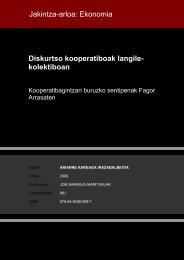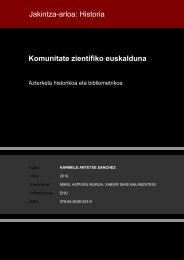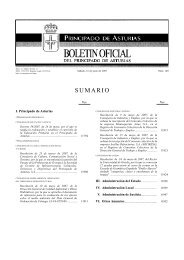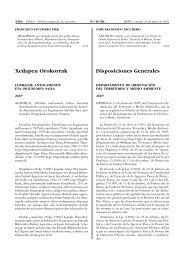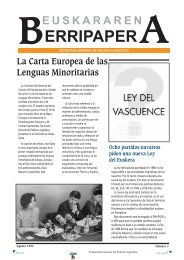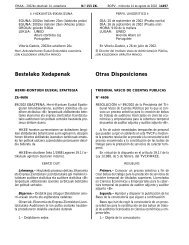MOLUSKUEN LISERI-GURUINEKO EPITELIOAREN ... - Euskara
MOLUSKUEN LISERI-GURUINEKO EPITELIOAREN ... - Euskara
MOLUSKUEN LISERI-GURUINEKO EPITELIOAREN ... - Euskara
You also want an ePaper? Increase the reach of your titles
YUMPU automatically turns print PDFs into web optimized ePapers that Google loves.
Emaitzak eta eztabaida<br />
Epithelial cell renewal in the digestive gland and stomach of mussels: season,<br />
age and tidal regime related variations<br />
Abstract: The natural variability in cell proliferation activity in the epithelium of the digestive gland and<br />
stomach was investigated in mussels, Mytilus galloprovincialis (Lmk), of different age and tidal level at<br />
different seasons. After treating mussels with the thymidine analogue bromodeoxyuridine (BrdU) for 6<br />
hours, BrdU immunohistochemistry was performed every 2 hours for the next 36. Then, the relative<br />
proportion of BrdU positive cells was quantified as BrdU labelling (‰). Marked seasonal differences were<br />
recorded in BrdU labelling, with much higher proliferating activity in summer than in autumn and winter. Cell<br />
proliferation seemed not to be significantly dissimilar between mussels of different age (size). In contrast,<br />
the digestive gland epithelium of mussels from intertidal and subtidal populations differed not only in the<br />
levels but also in the pattern of variation of BrdU labelling, which in intertidal mussels appeared to be<br />
modulated by photoperiod and tide, unlike in subtidal mussels, in which variations followed a circatidal<br />
pattern.<br />
Key words: bromodeoxyuridine immunohistochemistry, digestive cell, basophilic cell, cell epithelial<br />
renewal, circatidal rhythm, size, age, season, tide, bivalve.<br />
Renovación de células digestivas en glándula digestiva y estómago de<br />
mejillon: variación según la época, edad y régimen mareal<br />
Resumen: Se ha investigado la variabilidad natural en la actividad proliferativa de las células de la glándula<br />
digestiva y del estómago de mejillón, Mytilus galloprovincialis (Lmk), de diferente edad y régimen de marea<br />
en diferentes épocas del año. Los mejillones fueron tratados con bromodeoxiuridina (BrdU), un análogo de<br />
la timidina, durante 6 horas y en las siguientes 36 horas se realizó la immunohistoquímica de BrdU cada 2<br />
horas. A continuación, se cuantificó la proporción relativa de células BrdU positivas (‰). Se observaron<br />
diferencias significativas en el marcaje de BrdU relacionadas con la época del año, siendo la proliferación<br />
celular mucho más marcada en verano que en otoño e invierno. La proliferación celular no resultó diferente<br />
entre animales de diferentes edades (tamaño). Por el contrario, en el epitelio de la glándula digestiva de<br />
mejillones intermareales y submareales no sólo resultó diferente el nivel, sino también el patrón de<br />
variación del marcaje de BrdU. En mejillones intermareales ese patrón parece modulado por el fotoperiodo<br />
y la marea, a diferencia de los submareales en los que las variaciones siguen un patrón circamareal.<br />
Palabras clave: inmunohistoquímica de bromodeoxiuridina, célula digestiva, célula basofílica, renovación<br />
celular, ritmo circamareal, tamaño, edad, época, marea, bibalvio.<br />
120



